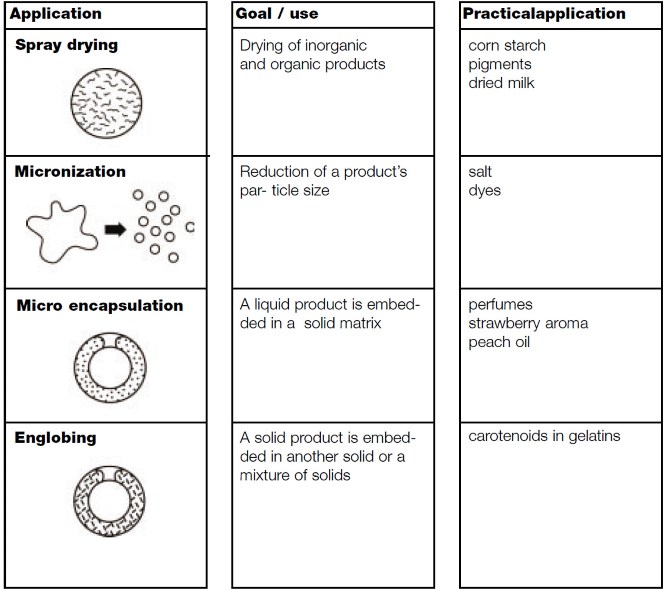Spray drying is a very widely applied, technical method used to dry aqueous or organic solutions, emulsions etc., in industrial chemistry and food industry. Dry milk powder, detergents and dyes are just a few spray dried products currently available. Spray drying can be used to preserve food or simply as a quick drying method.It also provides the advantage of weight and volume reduction. It is the transformation of feed from a fluid state into a dried particulate form by spraying the feed into a hot drying medium. Intensive research and development during the last two decades has resulted in spray drying becoming a highly competitive means of drying a wide variety of products. The range of product applications continues to expand, so that today spray drying has connections with many things we use daily.
Spray drying involves evaporation of moisture from an atomised feed by mixing the spray and the drying medium. The drying medium is typically air. The drying proceeds until the desired moisture content is reached in the sprayed particles and the product is then separated from the air. The mixture being sprayed can be a solvent, emulsion, suspension or dispersion.
1- Dispersion of the feed solution in small droplets
The complete process of spray drying basically consists of a sequence of four processes:
The dispersion can be achieved with a pressure nozzle, a two fluid nozzle, a rotary disk atomiser or an ultrasonic nozzle. So different kinds of energy can be used to disperse the liquid body into fine particles. The selection upon the atomiser type depends upon the nature and amount of feed and the desired characteristics of the dried product. The higher the energy for the dispersion, the smaller are the generated droplets.
2- Mixing of spray and drying medium (air) with heat and mass transfer
The manner in which spray contacts the drying air is an important factor in spray dryer design, as this has great bearing on dried product properties by influencing droplet behaviour during drying.
3- Open-cycle and closed cycle system
Air is mostly used as drying medium. The air stream is heated electrically or in a burner and after the process exhausted to atmosphere. This is a open-cycle system. If the heating medium is recycled and reused, typically an inert gas such as nitrogen, this is a closed-cycle system. These layout is typically chosen, when flammable solvents, toxic products or oxygen sensitive products are processed. The most common type of spray dryer is the open-cycle, co-current spray dryer. In such a design, the atomised feed and the drying air is simultaneously injected into a spray drying chamber from the same direction.
4- Drying of spray (removal of moisture)
As soon as droplets of the spray come into contact with the drying air, evaporation takes place from the saturated vapour film which is quickly established at the droplet surface. Due to the high specific surface area and the existing temperature and moisture gradients, an intense heat and mass transfer results in an efficient drying. The evaporation leads to a cooling of the droplet and thus to a small thermal load. Drying chamber design and air flow rate provide a droplet residence time in the chamber, so that the desired droplet moisture removal is completed and product removed from the dryer before product temperatures can rise to the outlet drying air temperature.Hence, there is little likelihood of heat damage to the product.
General applications
The list of materials which are successfully spray dried is enormous, so only general principles should be listed hereby:
 for receive complete article click "Training Papers Spray Drying"
for receive complete article click "Training Papers Spray Drying"


